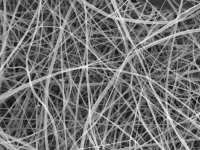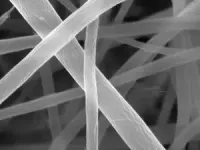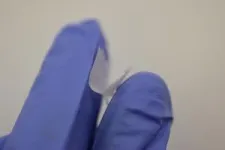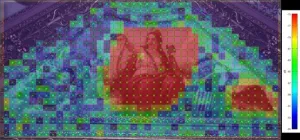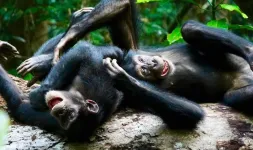(Press-News.org) The world’s thinnest spaghetti, about 200 times thinner than a human hair, has been created by a UCL-led research team.
The spaghetti is not intended to be a new food but was created because of the wide-ranging uses that extremely thin strands of material, called nanofibers, have in medicine and industry.
Nanofibers made of starch – produced by most green plants to store excess glucose – are especially promising and could be used in bandages to aid wound healing (as the nanofiber mats are highly porous, allowing water and moisture in but keeping bacteria out), as scaffolding for bone regeneration and for drug delivery. However, they rely on starch being extracted from plant cells and purified, a process requiring much energy and water.
A more environmentally friendly method, the researchers say, is to create nanofibers directly from a starch-rich ingredient like flour, which is the basis for pasta.
In a new paper in Nanoscale Advances, the team describe making spaghetti just 372 nanometres (billionths of a metre) across using a technique called electrospinning, in which threads of flour and liquid are pulled through the tip of a needle by an electric charge. The work was performed by Beatrice Britton, who carried out the study as part of her master’s degree in chemistry at UCL.
Co-author Dr Adam Clancy (UCL Chemistry) said: “To make spaghetti, you push a mixture of water and flour through metal holes. In our study, we did the same except we pulled our flour mixture through with an electrical charge. It’s literally spaghetti but much smaller.”
In their paper, the researchers describe the next thinnest known pasta, called su filindeu (“threads of God”), made by hand by a pasta maker in the town of Nuoro, Sardinia. This pasta lunga (“long pasta”) is estimated at about 400 microns wide – 1,000 times thicker than the new electrospun creation, which, at 372 nanometres, is narrower than some wavelengths of light.
The novel “nanopasta” formed a mat of nanofibers about 2 cm across, and so is visible, but each individual strand is too narrow to be clearly captured by any form of visible light camera or microscope, so their widths were measured with a scanning electron microscope.
Co-author Professor Gareth Williams (UCL School of Pharmacy) said: “Nanofibers, such as those made of starch, show potential for use in wound dressings as they are very porous. In addition, nanofibers are being explored for use as a scaffold to regrow tissue, as they mimic the extra-cellular matrix – a network of proteins and other molecules that cells build to support themselves.”
Dr Clancy said: “Starch is a promising material to use as it is abundant and renewable – it is the second largest source of biomass on Earth, behind cellulose – and it is biodegradable, meaning it can be broken down in the body.
“But purifying starch requires lots of processing. We’ve shown that a simpler way to make nanofibers using flour is possible. The next step would be to investigate the properties of this product. We would want to know, for instance, how quickly it disintegrates, how it interacts with cells, and if you could produce it at scale.”
Professor Williams added: “I don’t think it’s useful as pasta, sadly, as it would overcook in less than a second, before you could take it out of the pan.”
In electrospinning, the needle in which the mixture is contained and the metal plate upon which the mixture is deposited form two ends of a battery. Applying an electrical charge makes the mixture complete the circuit by streaming out of the needle on to the metal plate.
Electrospinning using a starch-rich ingredient such as white flour is more challenging than using pure starch, as the impurities – the protein and cellulose – make the mixture more viscous and unable to form fibres.
The researchers used flour and formic acid rather than water, as the formic acid breaks up the giant stacks of spirals (or helices) that make up starch. This is because the layers of helices stuck together are too big to be the building blocks of nanofibers. (Cooking has the same effect on the starch as the formic acid – it breaks up the layers of helices, making the pasta digestible.)
The formic acid then evaporates as the noodle flies through the air to the metal plate.
The researchers also had to carefully warm up the mixture for several hours before slowly cooling it back down to make sure it was the right consistency.
END
Chemists create world’s thinnest spaghetti
2024-11-21
ELSE PRESS RELEASES FROM THIS DATE:
Empowering neuroscience: Large open brain models released
2024-11-21
The hippocampus is one of the most fascinating brain regions. Associated with the formation of memories, it also helps us to navigate through the world without getting lost. Sensory cortices on the other hand play an important role in how we perceive our environment and make appropriate movements, and how our brains determine what to focus on and what to ignore. While both regions have been extensively studied and many of their secrets revealed, there is still a lot we do not understand about them due to the high complexity of ...
From traditional to technological: Advancements in fresco conservation
2024-11-21
MELVILLE, N.Y., Nov. 21, 2024 – Fresco painting, a technique that dates back to antiquity, involves applying dry pigments to wet plaster, creating stunning artwork that can last for centuries. Over time, however, these masterpieces often face degradation due to delamination, where decorative plaster layers separate from the underlying masonry or structural plaster. This deterioration can compromise the structural integrity of the artwork, necessitating restoration efforts.
Historically, conservators have gently knocked on the plaster with their knuckles or small mallets to assess the condition of the fresco. By listening to the emitted sound, they could identify the delaminated areas ...
Design and imagination as essential tools during the climate crisis
2024-11-21
In Nature Partner Journals, ten researchers advocate the use of imagination in tackling the climate crisis. They focus specifically on urbanising river deltas, which are of great social and economic importance and highly vulnerable to climate change. "We scientists should not merely outline doomsday scenarios," says Professor Chris Zevenbergen. "Create a vision for people to believe in and work towards.”
From doomscenarios to desired outcomes
Due to the climate crisis, urban river deltas ...
Innovating archaeology: HKU scholars utilize immersive 3D tech to document and study the human past
2024-11-21
Archaeologists from the Faculty of Arts at the University of Hong Kong (HKU) are revolutionising the excavation and documentation of ancient sites with cutting-edge 3D immersive technologies.
Archaeology studies the human past through the excavation of things people made and used thousands of years ago – from architecture to objects like pottery bowls and animal bones from meals. Although many excavation projects create digital 3D models of what they uncover, archaeologists need new ways to meaningfully use those data. Some projects share 3D models with the public as tourism and teaching tools – ...
What's the story, morning glory?
2024-11-21
Photos
Morning glory plants that can resist the effects of glyphosate also resist damage from herbivorous insects, according to a University of Michigan study.
The U-M researchers also found the reverse: plants treated with and susceptible to glyphosate, the active ingredient in the herbicide RoundUp, are also susceptible to damage from insects. This suggests that glyphosate, a herbicide humans have introduced into the environment, can disrupt the co-evolution of plants and their insect herbivores. ...
The unsolved mystery sounds of the Southern Ocean #ASA187
2024-11-21
MELVILLE, N.Y., Nov. 21, 2024 – Mysterious, repeating sounds from the depths of the ocean can be terrifying to some, but in the 1980s, they presented a unique look at an underwater soundscape.
In July 1982, researchers in New Zealand recorded unidentifiable sounds as a part of an experiment to characterize the soundscape of the South Fiji Basin. The sound consisted of four short bursts resembling a quack, which inspired the name of the sound “Bio-Duck.”
“The sound was so repeatable, we couldn’t believe at first that it was biological,” said ...
These wild chimpanzees play as adults to better cooperate as a group
2024-11-21
Compared to children, adults don’t play as much, but social play into adulthood is considered a universal human trait. Play has a role in building tolerance, cohesion, bonding, and cooperation. By comparison, play in adults of other species has been considered rare, and yet a new study reported in the Cell Press journal Current Biology on November 21 shows that some chimpanzees, like people, continue to play often throughout their entire lives and especially before engaging in acts that require collective cooperation.
“We show that adult social play in chimpanzees can foster a range of cooperative behaviors, from dyadic interactions to complex, risky ...
Physical activity and all-cause mortality by age in 4 multinational megacohorts
2024-11-21
About The Study: In this pooled analysis of cohort studies, the association between physical activity and mortality risk remained consistent across the adult lifespan, which contrasts with other modifiable health factors, for which associations with mortality risk diminished with age. Given these findings, the promotion of regular physical activity is essential at all stages of adult life.
Corresponding Author: To contact the corresponding author, David Martinez-Gomez, PhD, email d.martinez@uam.es.
To ...
Prenatal diet and infant growth from birth to age 24 months
2024-11-21
About The Study: In this cohort study, a prenatal diet that aligned with the U.S. Dietary Guidelines was associated with reduced patterns of rapid and slow infant growth, known risk factors associated with obesity. Future research should examine whether interventions to improve prenatal diet are also beneficial in improving growth trajectory in children.
Corresponding Author: To contact the corresponding author, Monique M. Hedderson, PhD, email Monique.m.Hedderson@kp.org.
To access the embargoed study: Visit our For The Media ...
Obesity prevention at an early age
2024-11-21
About The Article: This editorial places results of the Greenlight Plus trial, recently published by JAMA, in context, including technological interventions and policies to help prevent childhood obesity.
Corresponding Author: To contact the corresponding author, Kevin G. Volpp, MD, PhD, email volpp70@wharton.upenn.edu.
To access the embargoed study: Visit our For The Media website at this link https://media.jamanetwork.com/
(doi:10.1001/jama.2024.24026)
Editor’s Note: Please see the article for additional information, including other authors, author contributions and ...
